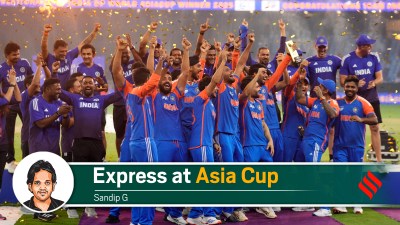Champs To Chokers
A week ago, Australia humiliated India in an ODI final for the third time in less than a year. For the third time, we’d battled through...

A week ago, Australia humiliated India in an ODI final for the third time in less than a year. For the third time, we’d battled through most of the distance — in this case a memorable, gruelling Test series — only to collapse in a heap with the finishing line in sight.
Sunil Gavaskar had a word for it: Chokers. Imran Khan, never one to let an opportunity slip, seconded it. The story was simple: Indian cricketers, currently the world’s most graceful, elegant team, have one fatal chink in their formidable armour, a chink that has been spotted by Australia and will be picked up by others: they lack the toughness to stay the course. We’re not talking about eyeballing Hayden or copping a Lee snorter on the elbow; nor even winning a Test. We’re talking about playing an entire series, all 10 weeks of it, to plan, controlling the peaks and dips in form.
Because India can’t seem to perform over a period of time — or, especially in ODIs, when it matters. And it’s not just against Australia: against England in 2002 India led 3-1 but the series ended 3-3; against West Indies we led the Tests 1-0, lost the series 1-2; against New Zealand we levelled the series at 2-2, only to lose the final match.
So why do we freeze in the final frame? Why don’t we time our runs well? Why don’t we peak at the right time? And the corollary: Why do such questions never bother the Aussies?
The answer lies in, among other places, Dennis Lillee’s The Art of Fast Bowling, written a long before Australia turned mental toughness into as potent a cricket weapon as the bouncer or the cover-drive. ‘‘It’s a dog-eat-dog world at the top in sports’’, Lillee wrote. ‘‘You cannot afford to give even a little to your opponent both in the other teams and those who share your battle for a place in the side.’’
It’s an attitude, as Trevor Chesterfield has detailed elsewhere, that Australians (and New Zealanders and South Africans) cultivate from childhood. It comes with the territory, it is part of their identity: fight for what you have for it will be taken from you if you don’t perform. So they raise their game when it matters (see box).
|
|
|
Visit any cricket academy — there’s at least one in your neighbourhood — and observe the coaching for a couple of hours. Running, stretching, a bit of batting, a bit of bowling. Planning and strategising don’t figure. Move up to the Ranji level. Things are different, but barely so; few Ranji players are told, at the beginning of the season, what their individual targets should be, what is expected of them, what the team’s ambitions are…
|
|
|
Andrew Symonds can never match the talent, grace or strokeplay of VVS Laxman but he delivers when the team needs. If Laxman is a sherwani of the purest silk, Symonds, despite facing little pressure for his place, is an everyday reliable pair of jeans.
Mental strength isn’t just an attitude to win by. It’s also the ability to deal with defeat. The Australians, famously, deal with defeat by discussing, analysing, crossing out mistakes until they are left with none. The Indians deal with defeat by not dealing with it. A day after the World Cup final at The Wanderers, the Indian team management issued a one-line whip to all players: No talk of cricket or world cup or final for a few days. The effect was evident at the TVS and VB series finals: we still didn’t have a plan to win in our minds.
What’s all the hype about the aggressive Indians, then? Well, it’s true: under Ganguly, India have acquired an edge, a competitive streak they didn’t have before. Sandy Gordon and his sessions have had short-term, focused impact. But to acquire Aussie toughness — if, indeed, they want to — will require a whole new system of cricket training.
Visit any cricket academy — there’s at least one in your neighbourhood — and observe the coaching for a couple of hours. Running, stretching, a bit of batting, a bit of bowling. Planning and strategising don’t figure. Move up to the Ranji level. Things are different, but barely so; few Ranji players are told, at the beginning of the season, what their individual targets should be, what is expected of them, what the team’s ambitions are…
|
The National Cricket Academy was set up in in 2000 with the intention of providing the best coaching to the brightest prospects. Yet it already has fierce critics. Former national coach Anshuman Gaekwad question the NCA’s off-season plans. ‘‘They give the juniors a schedule after their stint at the academy but they don’t involve the state association to see that they adhere to the plan,’’ he complains.
NCA director Brijesh Patel agrees to this flaw in the system but he says that he has a solution ready. ‘‘Soon we will be having zonal trainers and physios who will take care of the NCA trainees during off-season,’’ he says.
Is the NCA a system with which we can match the Aussies? Patel is honest enough to confess, ‘‘We can’t compare ourselves with the Aussies. They have better officials, better tactics, better players. Our system can’t match them.’’
But he’s upbeat on the future. ‘‘Such things don’t happen overnight, we need to have some patience.’’ He points to the impact of Gordon’s sessions with the national teams, the emergence of a tough new breed — Irfan, Yuvraj, Parthiv — and says the Australian psychiatrist will, after his countrywide tour to ‘understand the Indian psyche’, talk to the juniors cricketers at the camp.





- 01
- 02
- 03
- 04
- 05


























